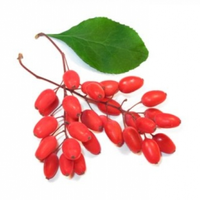Barberry

When the barberry is mentioned, candies with unforgettable taste from childhood immediately pop up in memory. In fact, barberry is a wonderful shrub in its beauty and benefits, which bears fruit with beautiful berries, in color and shape reminiscent of those same caramels.
Barbaris is considered a plant in our planet's Northern Hemisphere. The use of barberry for decorative purposes is widely known, it forms unique "living" hedges with bright fruits preserved on branches until deep autumn. The taste of barberry fruits is tart-sour, for these properties barberries are otherwise called "northern lemon. " Not only for its taste, the barberry received such an unofficial name. The beneficial properties of barberry are also widely known and have long been used by humans.
The benefits of barberry
The benefits of barberry were known back in Ancient Russia. The unique medicinal properties of barberry are due to its composition. in all parts of this plant, except perhaps the fruits contain a unique alkaloid berberin. It has a powerful and effective choleretic effect. Tinctures and decoctions from barberry bark are used to treat jaundice, gallbladder and liver diseases.
Traditional medicine honors barberry for its excellent hemostatic effect and recommends using this plant for various types of bleeding. As for the benefits of barberry, namely, its berries, their ability to improve appetite is clearly recognized here. Barberry fruits are a natural antibiotic and serve as an excellent therapeutic and preventive agent for hypertension, weakening of the immune system. Also, barberry is able to reduce blood pressure, reduce tumors.
In folk medicine, barberry berries infused with water are actively used to relieve rheumatic pains. Barberry is useful for diabetes mellitus, because the sugar content in it is minimal. The effective anti-inflammatory and antitussive effects of barberry are known, so these bright red berries are extremely useful for sore throat and numerous colds.
Barbaris unequivocally found and took his pride of place in cooking. Its fruits are used to prepare jelly, jam, compote, juices, syrups. Barberry is used as a spicy additive to various sauces. Dried barberry is a great addition to meat dishes. It is actively used in this form among the peoples of the Caucasus. Sometimes barberry berries are harvested slightly unripe, and then salted or marinated and so served to various dishes. It is worth noting that the calorie content of barberry is only about 30 kcal. per 100 gr.
Harms of Barberry
It should be remembered that the fruits of barberry should not be consumed in an unripe form due to the content of poisonous substances. Also, the harm of barberry can affect people suffering from cirrhosis of the liver, cholelithiasis. Barberry is contraindicated for young children and pregnant women.
barberry 29.6 kCal
The energy value of barberry (Ratio of proteins, fats, carbohydrates - ju):
Proteins: 0 g (~ 0 kCal)
Fats: 0 g (~ 0 kCal)
Carbohydrates: 7.9 g (~ 32 kCal)
Energy ratio (bj | y): 0% | 0% | 107%
 Español
Español Français
Français Português
Português Русский
Русский 简体中文
简体中文 繁體中文
繁體中文 日本語
日本語 한국어
한국어 العربية
العربية Türkçe
Türkçe Қазақ
Қазақ Deutsch
Deutsch Italiano
Italiano Українська
Українська
